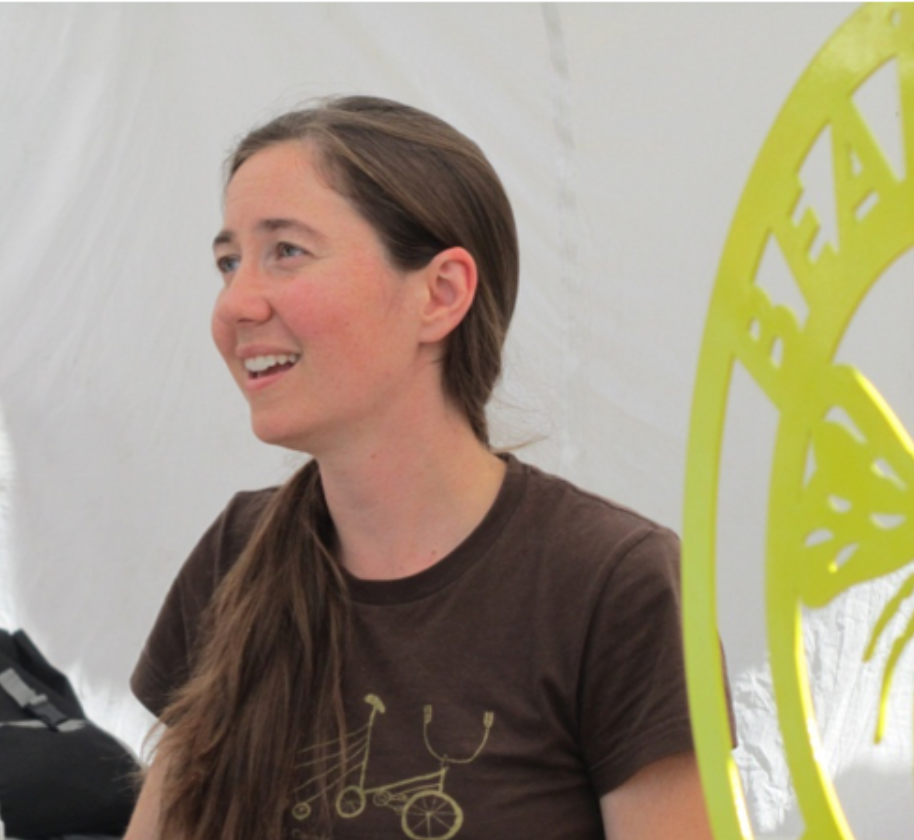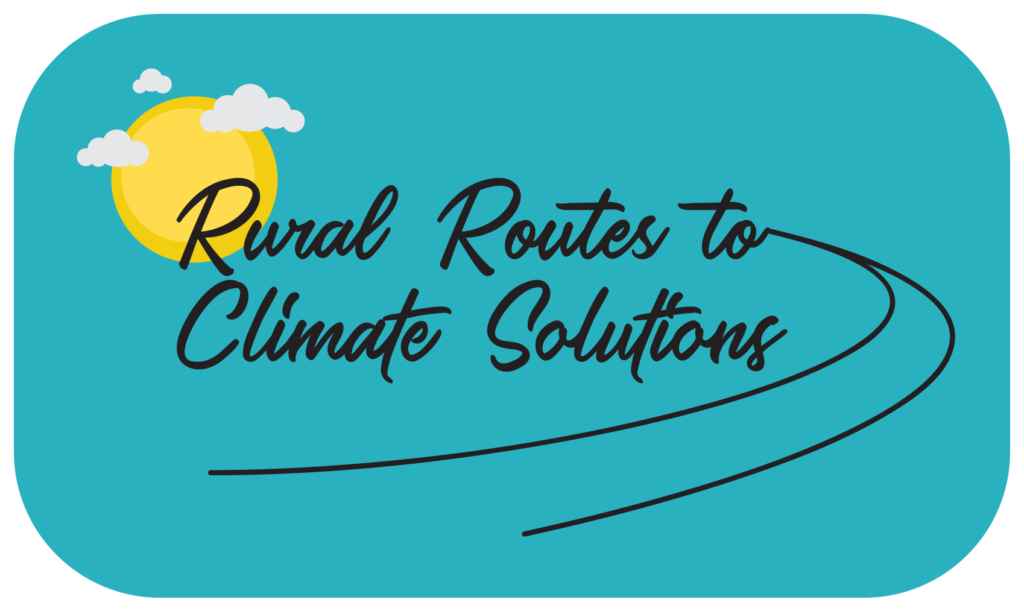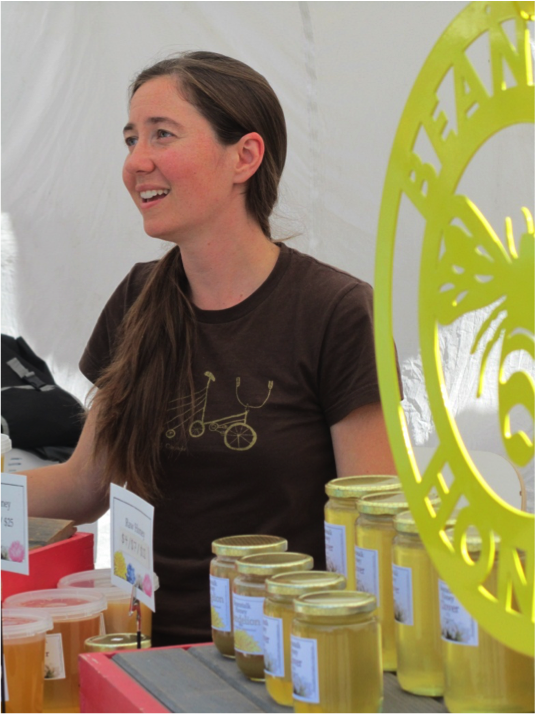 From Alaska to Alberta, one beekeeper’s story of promoting local food security – and working for ‘queen security’ – amidst a rapidly changing environment
From Alaska to Alberta, one beekeeper’s story of promoting local food security – and working for ‘queen security’ – amidst a rapidly changing environment
By Trina Moyles
Tracey Smith grew up near North Cooking Lake in Strathcona County and in Edmonton. During her undergrad degree in conservation biology at the University of Alberta, she became intrigued by questions of food security in the North. After graduating, Tracey moved to Fairbanks, Alaska to pursue a Master’s of Arts at the University of Fairbanks. Her research on the North compared the carbon footprint of raising backyard laying hens compared to that of importing eggs from the lower 48 states. Around the same time, Tracey began volunteering on a vegetable farm near the university. The farmer also kept a few hives for pollinating the vegetables. At the time, Tracey was living in a rustic cabin – no running water – and becoming disenchanted with academia. She wondered what kind of career to pursue.
“This was when I discovered that I was really interested in farming and beekeeping,” reflects Tracey. “But the more I got into beekeeping in Fairbanks, however, I began to realize that Alberta is a huge honey producer. There are hundreds of thousands of colonies here and multi-generational apiaries.”
In 2010, Tracey moved south and got started on her family’s farm near North Cooking Lake. She grew vegetables and kept a few hives, mostly just for pollination. But that first summer, she struggled to sell her vegetables, whereas, the honey sales flowed. That’s when she decided to concentrate solely on honey. Tracey dove right into the world of beekeeping, attending conferences and workshops, and talking to beekeepers whenever she could. She was thrilled to get into local farmer’s markets to sell her honey. “I just really focused my existence on honey bees,” she laughs.
Today, Tracey runs Beanstalk Honey and sells her honey at the Old Strathcona Farmer’s Market in Edmonton, and through a new online market. She keeps bees without the use of antibiotics or chemical synthetics, overwinters her colonies, and breeds her own queens. Tracey has also developed curriculum for beekeeping and teaches a range of online courses – from marketing to overwintering hives – through Beanstalk Bees.
Recently, we interviewed Tracey about her journey into the world of beekeeping, learning about her approach to working with bees, the advantages of queen breeding, the value of biodiversity for nectar flows, and how changes in seasonal weather patterns are impacting honey bees.
 RR2CS: Can you tell us more about your approach to beekeeping? Who were some of your early mentors?
RR2CS: Can you tell us more about your approach to beekeeping? Who were some of your early mentors?
Tracey: I had some really good mentors who helped me out at the beginning. One of my first contacts was with our provincial apiculturist, Medhat Nasr. He was really kind. I had already bought bees and realized I didn’t know how to be a beekeeper – there’s a huge learning curve in beekeeping. I took a workshop with Medhat and learned so much about various aspects of beekeeping. Two years later, Medhat invited me to teach the marketing course for the same workshop, so it allowed me to take the course again and again. Through repetition, I really learned.
Another beekeeper and presenter, Tom Hegan, was teaching about seasonal management and a more self-sufficient approach to beekeeping. He was one of the early beekeepers who started overwintering their colonies in Alberta. Beekeepers used to kill their colonies every fall and buy new packages from the States, rather than overwintering their bees, but in the 1970s, there was a movement for more self-sufficient beekeeping. They put more effort into wintering their colonies, breeding their own queens in the springtime to replace their winter hive losses.
I learned a great deal with Tom and a handful of other beekeepers in Alberta and Saskatchewan. As a result, my approach is a bit different from many other beekeepers in Alberta. I don’t rely so much on buying packages in the springtime. I’m more focused on queen breeding and timing everything with natural nectar flows, instead of supplemental feeding.
RR2CS: What is supplemental feeding? How does your approach differ?
Tracey: With supplemental feeding, beekeepers start supplementing their colonies with protein and sugar syrup to jumpstart their bee populations in mid to late March. This is several weeks to a month earlier than naturally occurring pollen flows. Beekeepers will build young hives from their larger colonies, and then import queen bees from Hawaii to put into those younger colonies (because we can’t breed queens that early in Alberta).
With my approach, I don’t typically feed early. Instead, I wait for the natural pollen flows and it just naturally happens that the bees start building their populations in time with the environment. Basically, I time the population cycle with the natural environment, which allows me to breed my own queens.
RR2CS: Do most beekeepers get their queens from Hawaii?
Tracey: Yes, Hawaii is one of the largest breeders [and exporters] of queen bees to Alberta. Actually, right now Alberta beekeepers are concerned because Hawaii is getting hit by a hurricane right now and they’re worried how it might impact queen production.
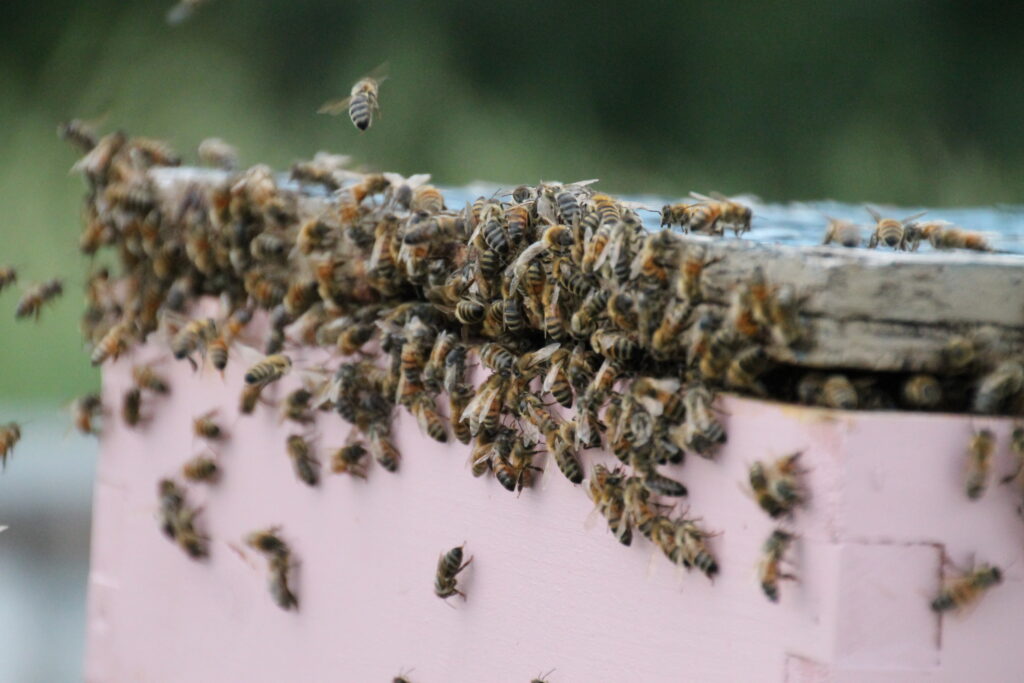 RR2CS: Does breeding your own queens give you more “queen security?”
RR2CS: Does breeding your own queens give you more “queen security?”
Tracey: I always thought if I’m breeding my own queens here, I would have more security than someone buying them from Hawaii. Some Albertan beekeepers will do both – a hybrid model. They import queens from Hawaii early in the season, but they’re also breeding their own queens later on in the season.
I think this hybrid approach is actually the most secure model. It’s good to not put all your eggs in one basket.
If the weather is bad in Hawaii, breed here. But if the weather is bad here, import from elsewhere. This took me a few years to learn.
RR2CS: How is the weather impacting your queen breeding in Alberta?
Tracey: If we have a late, cold spring, it will delay the bees, and the populations won’t be very large. For example, the queens need to fly out of their hives to mate with drones. They meet in what’s called a drone congregation area. The queens really only do one mating flight, more or less, in their entire lifetime. They store sperm inside their bodies and fertilize the eggs as they’re laying them. It’s only a week-long window that they’re mating, so the queens rely on warm, decent weather. In June and July over the past several years, the weather has been quite rainy and cold, so it’s been hard to breed the queens. This is why Hawaii does well with queen breeding as their weather is more consistently sunny and warm. If our weather patterns get out of sync with the bee’s natural cycles, they start to develop many health issues. On the flipside, if the weather is really hot in the spring, it can cause the plants to bloom too early. Come July, there’s no plants left for bees and it can be a challenge to get them ready for the winter. Over the past few years, the weather has been all over the place and bees are really susceptible to these changes.
RR2CS: If you observe the bees, you’re really observing the smallest environmental shifts.
Tracey: Oh, definitely. Every spring, the bees fly around my honey house – they can smell the honey from the previous year – like, ‘is there any food for us here?’ And you always know the exact moment the nectar starts flowing because all of a sudden, the bees will be gone and you don’t see them again.
It’s pretty neat that you get to know the very hour that nectar starts flowing again every Spring. It makes me understand what’s going on in the environment in a very precise way.
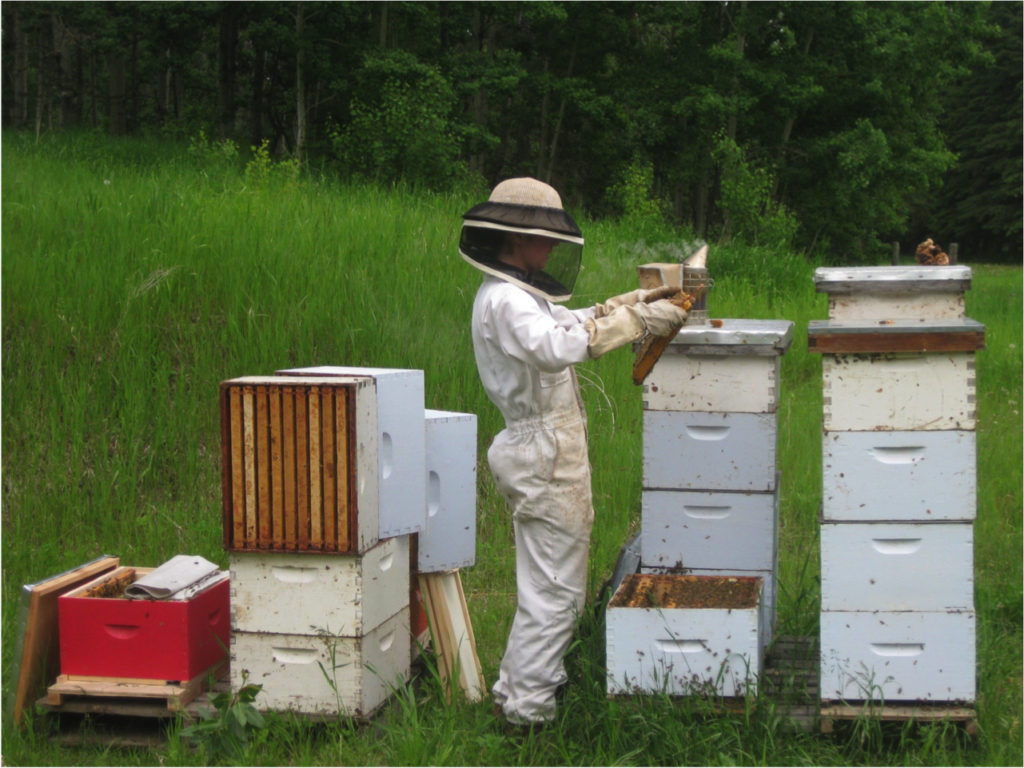 RR2CS: What is the importance of biodiversity in beekeeping?
RR2CS: What is the importance of biodiversity in beekeeping?
Tracey: Plants have different windows of time when they’re producing nectar. They’re impacted by temperatures in the day and at night, humidity, and so forth. It’s important to have a diversity of plants for bees to feed on. If you have only, say, canola, everything is riding on whether or not it will produce nectar, and what happens when that canola flow is done? But if you’re in an area that has canola, clover, alfalfa, along with stands of aspen, willow, raspberries and wild roses, there will always be nectar flow for the bees to feed on.
RR2CS: Can you tell us more about how you were involved in Alberta Agriculture and Forestry’s “Bee Health App”?
Tracey: Medhat Nasr invited me to help with the creation of the Bee Health app (designed to help beekeepers to detect, identify, manage and treat honeybee diseases and pests). As a team of apiarists, we listed the signs for different diseases and pests that affect honeybees. I helped write up the content and developed the algorithm for a sign checking component – where you can check off different signs of ill-health in your hives and the app determines the most likely pest. It’s a very cool resource for beekeepers in Alberta.
RR2CS: What experience do you have in disease identification? And what diseases are beekeepers dealing with today in Alberta?
Tracey: As an undergrad student, I was really good at bird identification. I’d see a flash of a bird in the woods and somehow, I’d just instantly know what it was. I’ve realized I can see things – moving things – really quickly. The same skill allows me to identify sick brood and bees really quickly. I didn’t think that was a unique skill until I was beekeeping in Florida and spent time with a number of beekeeping experts. I like to say that it’s my one unique ability as a beekeeper – I can really spot sick brood and bees quickly, for whatever reason.
The number one pest you hear about in the media all of the time is varroa mites, a parasitic mite that feeds on honeybees (and results in a disease called varroosis). It’s been an ongoing issue for beekeepers that can devastate our colonies.
But currently in Alberta, we’re seeing an outbreak in European foulbrood (EFB), a bacterial infection that affects the digestive tracts of the larvae in the hives. It’s rampant right now.
(Typically, EFB arises when there’s low food sources and resolve naturally with strong nectar flow). The causes are thought to be linked to the environment: weather and poor forage (in quality and quantity) leading to nutritional deficiency.
RR2CS: How have erratic freeze-thaw cycles impacted overwintering your hives?
Tracey: Up until 2016, I’d never really had major winter losses, but over the past few years, I’ve been getting walloped. I’m not sure if a freeze-thaw cycle in December makes that much of a difference. But a cold spring (in April, for example) can be really hard on the bees. In addition, we’ve been having really warm falls, but there’s no nectar flow, which tends to confuse the bees, too.
But if you want to talk about environmental changes, the biggest challenge is managing for cold and rainy summers. It’s a big problem.
Historically, our Alberta summers were perfect for bees: there was a willow flow, followed by dandelion, then clover and canola, all spaced by a few weeks to help build up the populations of honey bees. But the fluctuations in temperature and humidity impacts when the plants are blooming, which affects the bee’s natural cycles, too.
RR2CS: How are you and other beekeepers trying to adapt to these changes?
Tracey: I’m starting to think that supplemental feeding could be an answer. I manage my bees with the natural nectar flows, but if these flows aren’t going to be predictable anymore than supplemental feeding is what I’m going to have to do.
There’s a lot of interest in the beekeeping industry right now on fine tuning what we’re feeding our bees and when. Knowing when to feed the bees can help us adapt. Another thing I’ve seen beekeepers doing is shifting to wintering their hives indoors.
I’m a bit small for an indoor wintering facility, but many of the commercial beekeepers are transitioning to overwintering indoors because you can better control the climate. Neither of these solutions are ideal from a sustainability perspective, but if it’s what we need to do to keep bees alive and thriving in Alberta, well, then it’s an adaptation process.
RR2CS: What do you love most about beekeeping?
Tracey: Well, there’s two things I love.
One, being able to see the bees interacting with and responding to the environment. I think that’s really neat to have that window into the natural environment.
And also, I really love selling honey to people. It’s what motivated me when I was a grad student and asked myself: what is good, meaningful work?
Growing food for people is the most basic, fundamental good thing I could think of. I’ve always been motivated to connect people in the city with where their food comes from.
—

beanstalk honey - strathcona county
Tracey Smith is the beekeeper behind Beanstalk Honey, an operation located 30 km outside Edmonton in Strathcona County. Since 2010, Tracey has been beekeeping without using antibiotics or synthetic chemicals. She sells honey at local farmers markets, including the Old Strathcona Market in Edmonton, AB. Tracey also offers introductory beekeeping courses through Beanstalk Bees.
Learn more about Beanstalk Honey – https://northcookinglake.com/

